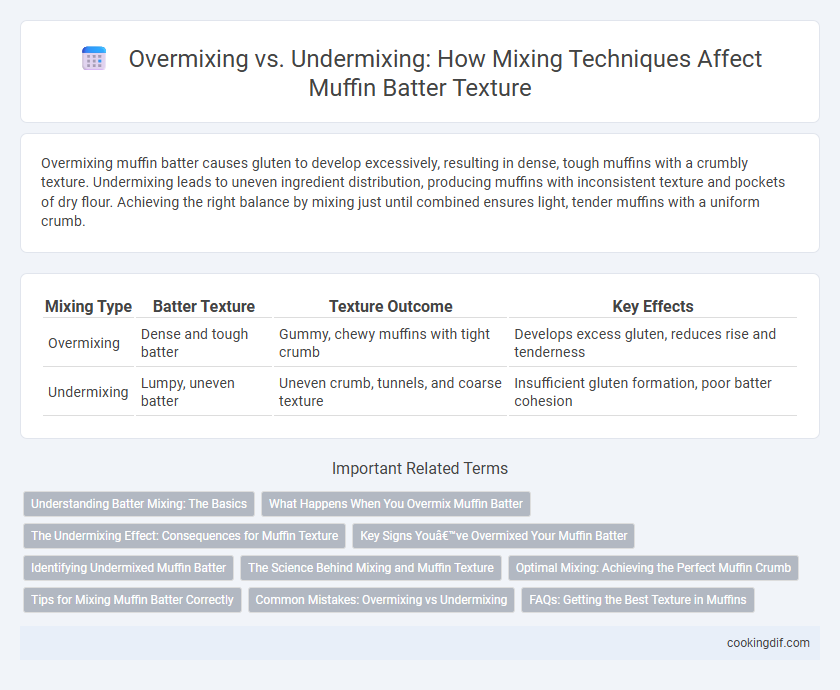Overmixing muffin batter causes gluten to develop excessively, resulting in dense, tough muffins with a crumbly texture. Undermixing leads to uneven ingredient distribution, producing muffins with inconsistent texture and pockets of dry flour. Achieving the right balance by mixing just until combined ensures light, tender muffins with a uniform crumb.
Table of Comparison
| Mixing Type | Batter Texture | Texture Outcome | Key Effects |
|---|---|---|---|
| Overmixing | Dense and tough batter | Gummy, chewy muffins with tight crumb | Develops excess gluten, reduces rise and tenderness |
| Undermixing | Lumpy, uneven batter | Uneven crumb, tunnels, and coarse texture | Insufficient gluten formation, poor batter cohesion |
Understanding Batter Mixing: The Basics
Proper muffin batter texture depends on balancing mixing time to prevent gluten overdevelopment or insufficient aeration. Overmixing causes a tough, dense crumb by activating too much gluten, while undermixing leads to uneven texture and tunnels due to trapped air pockets. Achieving a tender, moist muffin requires gently combining ingredients until just blended, preserving the right gluten structure and air distribution.
What Happens When You Overmix Muffin Batter
Overmixing muffin batter activates excess gluten formation, resulting in dense, tough muffins with a chewy texture rather than light and tender crumb. It also causes air pockets in the batter to collapse, leading to muffins that are heavy and unevenly risen. Proper mixing ensures a balance between gluten development and leavening, producing moist, fluffy muffins with a desirable texture.
The Undermixing Effect: Consequences for Muffin Texture
Undermixing muffin batter results in uneven distribution of ingredients, causing dense, lumpy textures and insufficient gluten development. This leads to muffins with coarse crumb structures and irregular rise due to trapped pockets of flour or leavening agents. Proper mixing balances ingredient integration without overworking, ensuring a tender yet well-aerated muffin texture.
Key Signs You’ve Overmixed Your Muffin Batter
Overmixed muffin batter often appears dense and tough due to excessive gluten development, resulting in a coarse, peaked top instead of a tender crumb. Key signs include a batter that is overly glossy and elastic, with muffins that tunnel or have irregular holes inside. Avoid overmixing by gently folding ingredients until just combined to maintain a moist and soft texture.
Identifying Undermixed Muffin Batter
Undermixed muffin batter appears lumpy with visible streaks of flour and unevenly distributed ingredients, resulting in dense, crumbly muffins. The texture often lacks elasticity, causing muffins to collapse or have tunnels inside after baking. Proper mixing ensures even hydration of flour and incorporation of leavening agents like baking powder or baking soda, crucial for achieving a tender, moist muffin crumb.
The Science Behind Mixing and Muffin Texture
Overmixing muffin batter activates excessive gluten development, resulting in a dense, tough texture, while undermixing leaves pockets of dry ingredients, causing uneven crumb and large tunnels. The ideal muffin texture balances gluten formation and air incorporation by mixing just until ingredients are combined. Understanding the interplay between mixing time and gluten matrix formation is essential to achieve tender, moist muffins with a fine crumb structure.
Optimal Mixing: Achieving the Perfect Muffin Crumb
Optimal mixing balances gluten development and air incorporation to create a tender yet structured muffin crumb. Overmixing leads to dense, tough muffins with large tunnels due to excessive gluten formation, while undermixing results in uneven texture and pockets of dry flour. Achieving the perfect crumb requires gently folding ingredients until just combined, preserving lightness and ensuring uniform crumb structure.
Tips for Mixing Muffin Batter Correctly
Overmixing muffin batter develops excessive gluten, resulting in dense, tough muffins with tunneling, while undermixing leaves pockets of dry flour and uneven texture. For an ideal crumb, gently fold wet and dry ingredients just until combined, leaving small lumps intact to ensure a tender, moist muffin. Use a light hand and mix quickly over low speed or by hand to balance hydration without overworking the batter.
Common Mistakes: Overmixing vs Undermixing
Overmixing muffin batter causes excessive gluten development, leading to tough, dense muffins with peaked tops and tunnels inside. Undermixing results in uneven distribution of ingredients, producing muffins with coarse texture and inconsistent crumb structure. Achieving the right balance ensures a tender, moist muffin with uniform crumb and optimal rise.
FAQs: Getting the Best Texture in Muffins
Overmixing muffin batter causes gluten development that results in tough, dense muffins with tunnels inside, while undermixing leaves pockets of flour and uneven texture. For the best muffin texture, mix the batter just until the dry ingredients are moistened, maintaining a lumpy consistency. Avoid excessive stirring to ensure tender, moist muffins with a light crumb.
Overmixing vs Undermixing for batter texture Infographic

 cookingdif.com
cookingdif.com